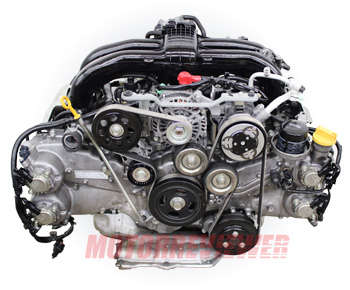Subaru FB20 2.0L Engine Specs, Problems, Reliability, Info

Subaru FB20/FB20B Overview
Subaru introduced the FB engine family in 2010, replacing the legendary EJ20 with the new flat-4 2.0-liter FB20. While the FB20 might at first glance appear similar to its predecessors, there are many changes inside and out. Let's take a closer look at the design of this 2.0L boxer motor, what is new about it, and talk about its weak points.
FB20/FB20B Engine Design
The FB20 engine features a new aluminum cylinder block, which has a decreased piston bore from 92.0 mm to 84.0 mm. Despite the smaller piston bore, the engine still has a 2.0-liter displacement thanks to a larger piston stroke. This change has also resulted in slightly more torque at lower revs. To maintain the same exterior dimensions as the EJ-series predecessor, the FB20 uses asymmetrical connecting rods.
The engine has new DOHC heads, with 4 valves per cylinder. The angle between the intake and exhaust valves has been reduced to 27 degrees (the EJ's angle was 41 degrees). The distance between the camshafts is also smaller: 104.0 millimeters instead of 126.0 millimeters. That was made possible by switching to chain-driven camshafts (EJ uses a timing belt). The narrow valve angle and smaller bore reduce unburned fuel during cold starts, thereby reducing emissions. Both camshafts, the intake and exhaust, are equipped with a variable valve timing system (Dual AVCS). The intake manifold is made from plastic material. This manifold has Tumble Generator Valve System (TGV) that manipulate the intake flow through electronic control in order to maximize efficiency.
Subaru said that they achieved a 28% reduction in friction losses by using lightweight pistons and connecting rods. This resulted in a 4% reduction in CO2 emissions and a 10% reduction in fuel consumption. The FB20 engine is more environmentally friendly while maintaining the same power output and providing a wider range of torque compared to the previous EJ20 model.
FB20X Engine
The FB20X engine was produced by Subaru between 2013 and 2017. It is a specially modified version of the FB20 engine designed for hybrid drivetrains in vehicles such as the Subaru XV Hybrid and Subaru Impreza. This version has a 10.8 compression ratio and includes different pistons, as well as several minor changes aimed primarily at reducing internal friction. The hybrid engine's power output is comparable, but the combined system output (engine + electric motor) is higher to that of a regular FB20B engine.
Updates
In 2017, the FB20B engine was replaced by a newer version, the FB20D. This new engine features a direct fuel injection system and a very high compression ratio of 12.5. A little later, the manufacturer introduced the FB20D e-Boxer for hybrid models, replacing the FB20X.
Engine Specs
10.8:1 — FB20X
API SM/SN (ILSAC GF-4 or GF-5)
Oil recommendations and capacity may vary depending on the car model, year, and market. Please check the service manual specific to your vehicle!
FB20 Engine Problems and Reliability
Flat-four engines often have an unusual and exotic design, which can sometimes cause problems. Unfortunately, the FB20 is not an exception. Here are some of the most common issues:
- A high oil consumption is a widespread and well-known problem with the FB20. The engine may consume oil even from the first miles.
- The engine can easily become overheated, and the damage from overheating can be significant.
- It is very important to use the oil recommended by the manufacturer. Otherwise, you could damage the phase adjusters.
- Some owners have complained about the noise and vibration of the FB20 engines. This problem seems to get worse as the oil level drops. Therefore, it is best to keep the oil level high.
Summary of Reliability
Subaru boxer engines have never been known for their longevity. The FB20 model is nothing special about it. The approximate engine lifespan is close to 200,000 miles (300,000 km), which is average for gasoline 2.0-liter engines. To prolong the engine's life, it's important to use the recommended oil and change it more often than the scheduled intervals. Also, minor issues should be fixed in a timely manner.
